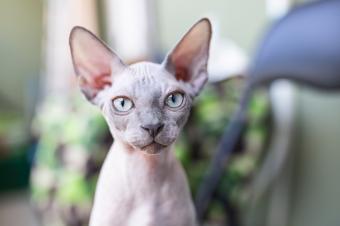
Animal lovers are familiar with the adorable Russian blue cat breed. There are many other unique Russian cat breeds, including the Ural rex and Peterbald. The history behind each cat is fascinating. For example, the Russian blue originated around the Russian Port of Archangel, just below the Arctic Circle.
Russian Cat Breeds
There are seven feline breeds every cat owner needs to add to the shortlist when choosing a kitty. If a Russian feline breed is a priority, pet parents need to find reputable cat breeders. The International Cat Association's website (TICA) includes a list of reputable breeders.
Donskoy
The Donskoy breed is a social cat with a pear-shaped body. There are various coat types, and some are hairless. Other coat types may be fuzzy or slightly wavy. Grooming is low-maintenance! This cat breed is friendly, active, and easily trained.

Peterbald
Cat owners describe the Peterbald breed as graceful and capable of aerial ballet. This rare and uncommon cat is known for his pleasant temperament. The breed is relatively new and a cross between the Donsky and Oriental shorthair. The various coats include hairless, a fine soft down or dense, stiff coat.

Ural Rex
The Ural rex cat breed is unusual looking and popular in Russia. The kitten's coat is half-closed curls, and as the cat ages, the curls turn into waves. The curls are also elastic and may take two years to develop fully.

Siberian
The infamous Siberian cat breed is one the largest cat breeds available. This breed is giant and may weigh up to 20 pounds! The Siberian's coat withstands cold temperatures, and the breed is also known for tufted paw pads and a bushy tail. This cat is highly athletic and loyal to his owners.

Neva Masquerade
This breed is the color point version of the Siberian. Named after the Neva River in St. Petersburg, this feline's ultra-thick coat needs regular grooming. The Neva Masquerade is calm and fearless.

Kurilian Bobtail
This cat originated in the Kuril Islands and remains popular on the Russian mainland. The breed is known for its distinctive short tail. A Kurilian bobtail adores family life and loves attention.

Russian Blue
All animal lovers know about the beautiful Russian blue cat breed. The cat originated around the Russian Port of Archangel, just below the Arctic Circle. The green eyes and silvery-blue coat of Russian blue cats are why this breed is so popular.

Questions for Reputable Breeders
A contract needs to be signed and always ask for references. For example, you may need to ask the breeder about the coat color of the parents. Mating two Russian blues with a blue coat gene guarantees a litter of blue kittens. If a Russian blue is bred to a black Russian shorthair, both blue and black kittens may result.
- What are the characteristics of this breed?
- How are the kittens raised?
- Do you provide a written agreement?
- What diseases does a health guarantee cover?
Finding a Kitty
There are important questions to ask as you research breeds whether the cat originates in Russia or the U.S.
- What can you expect from a responsible breeder?
- How can you tell if your kitty is healthy?
- How can you tell if a kitten is well socialized?
- Why buy from a responsible breeder?
- What should you do after you bring a kitten home?
Russian Cat Breeds Grow in Popularity
Many of these breeds are uncommon and almost rare in the U.S., so pet parents may need to research breeders abroad for kitties. The Siberian is gaining popularity, but the Ural rex may only live in Russia, and the coat on this cat breed is precious. Always work with a reputable breeder and read the contract carefully before purchasing a kitty.







